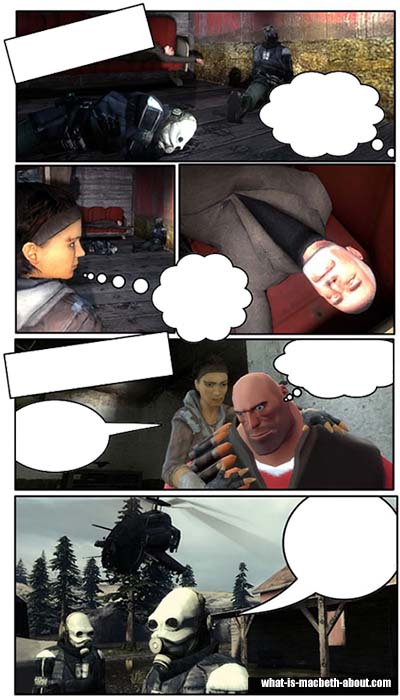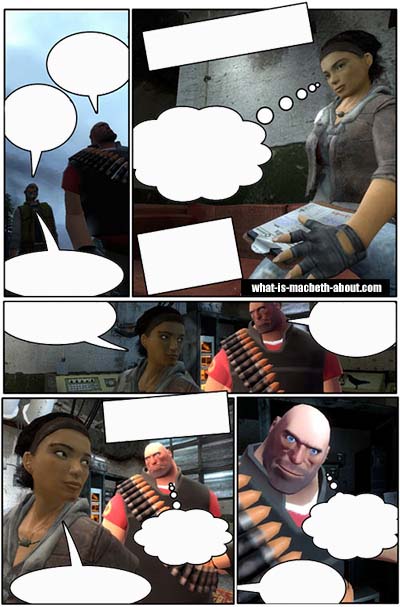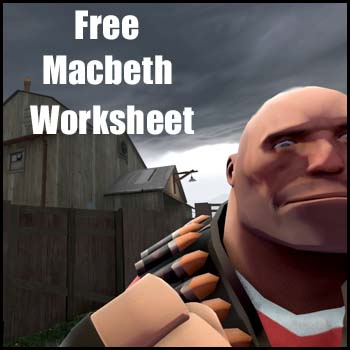Create a Macbeth Summary
Macbeth Worksheet – a Summary Based on the Website
https://what-is-macbeth-about.com
Many students find Shakespearean language impenetrable.
‘What the (insert expletive here) are they talking about?’ is not an uncommon utterance during the literary discourse of high school classrooms. 😉
If you then mix this ‘inaccessibility of the language’ with an abhorrence for the ‘over analysis’ at the sentence level, many students miss the beauty, themes, insight into the human condition and complexities of how the narrative is woven. This is, of course, is a complete tragedy. It means many students leave Shakespeare bleeding on the classroom floor, never to be revisited.
Enter the FREE Blank Graphic Novel Template!

This free template encourages students to create a no-fuss graphic novel summary of Macbeth. All the dialogue and narration has been removed from the template so students must visit a website, read the summary of the play and fill in the blanks to create their own graphic novel. The aim is for students to finish the activity with an overarching understanding of the play’s content, structure and schema before they approach the formal study of the play. As a byproduct of this process is they might actually enjoy the play.
How it Works:
1. Print off the graphic novel template from https://what-is-Macbeth-about.com
2. Read through each page of the online Macbeth summary from the same site and fill in the blanks in the template.
NB I believe if students do this activity in pairs (2 templates with 1 internet-enabled device) the discussions they have about what to write down is valuable on many levels.
Preparation:
* Email a copy of the blank template or the link to the download page to each student.
* Encourage the students to print out the template in color.
Tip for Young Players:
* Have photocopied copies of the blank template handy for those that didn’t, couldn’t, wouldn’t or… ‘forgot’ to print it out at home.

Kicking off the Activity:
DO NOT JUST COPY THE TEXT FROM THE SCREEN TO THE TEMPLATE. NO POWERFUL LEARNING HAPPENS BY DOING THIS! #putssoapboxaway
Summary of Macbeth – a Tried and Proven Process
1. Teacher models reading the first page and leads into discussion.
2. In pairs students discuss and record what they think should be written.
3. Students form groups of four (Think. Pair. Square) and discuss what they have included. Compare.
4. Teacher facilitates discussion on what should be recorded and why.
5. Repeat this process for pages 2 & 3.
6. Students complete the paired summary.
7. Think. Pair. Square.
8. Model Annotation – Return to the graphic novel summary over the course of study to add annotations.
A Tried and Proven Process – Fleshed Out a Little More
Step 1.
– Teacher models the discusses: What is happening (events), What is being said (dialogue) & What is being thought (internal dialogue) in each panel of the first page.
– Include in the discussion how the purpose of this activity is to enable a deeper understanding of the play’s schema and the key overarching events.
– Be sure to mention how completing this task will help them retain a working knowledge of the play for future, more in-depth, tasks.
– Discuss the metacognition (learning about learning) of how when people simply copy word for word, the current thinking is the person’s ‘cognitive load’ is spent focusing on writing the words not understanding the meaning of the text. They are just ‘copying’ letters and are not interacting with the content, ideas or constructing deeper meaning. And how this is not effective learning in most cases.
Step 2.
– Have pairs fill in Page One of the template.
– Include the narrator’s voice in the rectangles, dialogue in the speech bubbles and thoughts in the thoughts bubbles.
Typography – If they wish their comic to stay true to the graphic novel conventions all lettering must be done in capitals.
Step 3.
– Square – Students form their pairs into groups of 4. They swap their template pages and read them silently. Next, they discuss the similarities and differences in each others’ versions i.e. what has been included, left out and why.
Step 4.
– Come back together as a whole class to discuss the first page.
– Encourage annotations and arrows to clarify events etc.
Step 5.
– Repeat steps 1 to 4 until you are confident they are ready complete the summary without simply copying the text from the screen.
Step 6.
– Students complete the template. During this time teacher roves the groups. Stopping to offer guidance, witty repartee and to make informal notes on skills requiring further
development.
– If students do not finish the template in one session encourage them to finish it off at home.
Step 7 – Think. Pair. Square.
– In the next session join pairs together to form groups of 4 (squares).
– Students compare their panels and discuss what they would add, what they would leave out and why.
Step 8 – Model How to Annotate.
– Teacher models annotating the template using the areas of focus they wish to cover.
* Discuss the notion of annotations being personal and students need to discover what works for them.
– annotations can happen during reading or after reading.
Annotate. Annotate. Annotate – a Few Thoughts and Possibilities in No Particular Order
* Include your observations on different/interesting aspects of the play.
* Use different colored pens to develop your own code.
* Include your thoughts on various quotes e.g. How true is the statement? ‘This dead butcher and his fiend-like queen.’?
* Use words and arrows to note the changes in Macbeth and Lady Macbeth as the play unfolds esp psychologically.
* Write definitions / ‘good words’ to work into essays on the back of the template. PTO works well. Here are a few ‘gems’ to get you started – regicide – despot – usurp – Draw a ‘heath’ – soliloquy – dramatic irony – metaphor – maintain mood – create atmosphere – personify – allusion – prophecy… to name but a few.
* Mark examples of ‘dramatic irony’ – e.g Duncan arriving and complementing his host all the while the audience knows she his plotting to kill him.
* Use arrows to show where some of the famous quotes would appear in the unabridged version of the play e.g. ‘My mind is full of scorpions’? ‘… a tale told by an idiot…’, ‘A little water will cleanse us of this deed…’, etc
* Arrows to the creation of mood and atmosphere – esp light and weather.
* Do ‘Clothes maketh the Man’? ‘Why do you dress me in borrowed robes?’ ‘Fetch me my armour’.
* Record some of your big picture questions. Ones you think an ‘expert’ on the play might be able to answer e.g. Why do the witches do the things they do to Macbeth? Was Macduff referring to Cesarean Section when he said, ‘From his mother’s womb untimely ripped’?
The Last Frame:
The last frame of the template echoes Polanski’s ‘Macbeth’ where Donalbain (Banquo’s Son) visits the witches. NB This is not in Shakespeare’s original text.
Why do you think the author’s have added it? Just for starters —> Think back to the prophecies regarding Banquo and his children being future kings and in the light of how the witches ‘misled’ Macbeth.

You Can Download The Complete Fill in the Blanks Macbeth Template for FREE from One of these Places.
TeachersPayTeachers – FREE Macbeth Worksheet
TES UK – FREE Macbeth Worksheet
Known Download Issue – some phones do not like zip files. If you cannot download this worksheet on your phone or tablet, it definitely on desktop or laptop.
 |